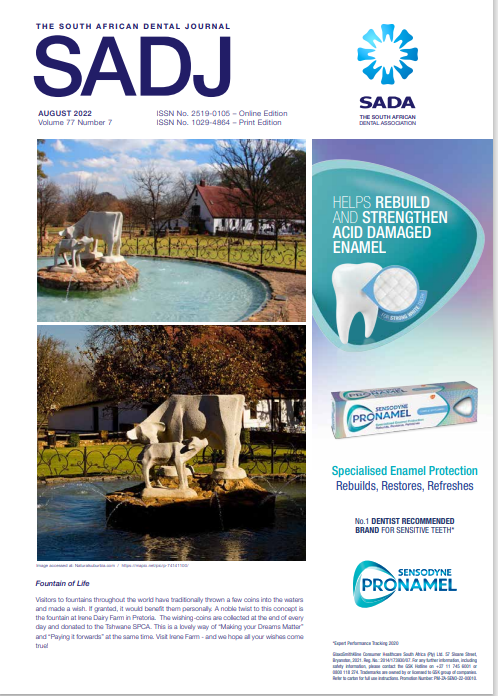An evidence-based guide to occlusion and articulation. Part 7: Guidelines for mechanical articulator use; conclusions and a note on complexity
DOI:
https://doi.org/10.17159/2519-0105/2022/v77no7a7Keywords:
adjustments, bilateral centric contactsAbstract
Although this is essentially a review, it has not been written in the passive, third-person style normally associated with scientific writing, as it is intended to be thought-provoking and, hopefully, educational. It has therefore been written in more of a conversational style,
and is aimed at students, dentists and dental technicians who are receptive to a slightly different view of occlusion and articulation, based on evidence. Occlusion is a topic that has become a kind of archaic minefield of conflicting ideas, propositions, and above all,
solutions, most of which are based on a complete lack of understanding of the evolution and development of teeth, and by extension, of clinically objective evidence. That in itself is a statement of conflict (and perhaps even heretical), but it is by way of warning that this guide is not going to be much like anything you will find in standard text-books of dentistry or dental technology. It is, rather,
an attempt to help you navigate through what you will read elsewhere, in the hope that eventually you will find an understanding that you can live with. It will appear as a sequential series in 7 Parts.
Downloads
References
Ellinger CW, Wesley RC, Abadi BJ, Armentrout TM. Patient response to variations in denture technique. Part VII: Twenty-year patient status. J
Prosthet Dent. 1989;62(1):45-8. doi: 10.1016/0022-3913(89)90045-0
Regis RR, Cunha TR, Della Vecchia MP, Ribeiro AB, Silva-Lovato CH, de Souza RF. A randomised trial of a simplified method for complete denture fabrication: patient perception and quality. J Oral Rehabil. 2013;40(7):535-45. doi: 10.1111/joor.12063.
Mengatto CM, Gameiro GH, Brondani M, Owen CP, MacEntee MI. A Randomized Controlled Trial of Mastication with Complete Dentures Made by a Conventional or an Abbreviated Technique. Int J Prosthodont. 2017;30(5):439–444. doi: 10.11607/ijp.4741.
Kawai Y, Muarakami H, Feine JS. Do traditional techniques produce better conventional complete dentures than simplified techniques? A 10-year follow-up of a randomized clinical trial. J Dent. 2018;74:30-36. doi: 10.1016/j.jdent.2018.04.027
Owen CP. Guidelines for a minimum acceptable protocol for the construction of complete dentures. Int J Prosthodont. 2006 Sep-Oct;19(5):467-74.
Owen CP, MacEntee M. The CD4 Denture Technique – Complete dentures delivered in three visits. Available at www.appropriatech.com
Owen CP. Lingualised Occlusion. An eBook module. Available at www.appropriatech.com
Zhang YJ, Shi JY, Qian SJ, Qiao SC, Lai HC. Accuracy of full-arch digital implant impressions taken using intraoral scanners and related
variables: A systematic review. Int J Oral Implantol. 2021;14(2):157-179
Sacher M, Schulz G, Deyhle H, Jäger K, Müller B. Accuracy of commercial intraoral scanners. J Med Imaging. 2021;8(3):035501. doi: 10.1117/1.
JMI.8.3.035501
Lepidi L, Galli M, Mastrangelo F, Venezia P, Joda T, Wang HL, Li J. Virtual Articulators and Virtual Mounting Procedures: Where Do We Stand? J Prosthodont. 2021;30(1):24-35. doi: 10.1111/jopr.13240.
Lo Russo L, Caradonna G, Troiano G, Salamini A, Guida L, Ciavarella D. Three-dimensional differences between intraoral scans and conventional impressions of edentulous jaws: A clinical study. J Prosthet Dent. 2020;123(2):264-268. doi: 10.1016/j.prosdent.2019.04.004.
Radu M, Radu D, Abboud M. Digital recording of a conventionally determined centric relation: A technique using an intraoral scanner. J Prosthet Dent. 2020;123(2):228-231. doi: 10.1016/j.prosdent.2018.12.004.
Seo JM, Oh WS, Lee JJ. A technique for verifying the accuracy of the virtual mounting of digital scans against the actual occlusal contacts. J Prosthet Dent. 2019;121(5):729-732. doi: 10.1016/j.prosdent.2018.08.003.
Yee SHX, Esguerra RJ, Chew AAQ, Wong KM, Tan KBC. Three-Dimensional Static Articulation Accuracy of Virtual Models - Part I: System Trueness and Precision. J Prosthodont. 2018;27(2):129-136. doi: 10.1111/jopr.12723.
Lepidi L, Chen Z, Ravida A, Lan T, Wang HL, Li J. A Full-Digital Technique to Mount a Maxillary Arch Scan on a Virtual Articulator. J Prosthodont. 2019;28(3):335-338. doi: 10.1111/jopr.13023
Solaberrieta E, Garmendia A, Minguez R, Brizuela A, Pradies G. Virtual facebow technique. J Prosthet Dent. 2015;114(6):751-5. doi: 10.1016/j.
prosdent.2015.06.012.
Li J, Chen Z, Decker AM, Wang HL, Joda T, Mendonca G, Lepidi L. Trueness and Precision of Economical Smartphone-Based Virtual Facebow
Records. J Prosthodont. 2021 Apr 20. doi: 10.1111/jopr.13366. Epub ahead of print.
Li Q, Bi M, Yang K, Liu W. The creation of a virtual dental patient with dynamic occlusion and its application in esthetic dentistry. J Prosthet Dent. 2020 Dec 12:S0022-3913(20)30593-X. doi: 10.1016/j.prosdent.2020.08.026. Epub ahead of print.
Li L, Chen H, Zhao Y, Wang Y, Sun Y. Design of occlusal wear facets of fixed dental prostheses driven by personalized mandibular movement. J Prosthet Dent. 2021 Feb 3:S0022-3913(20)30723-X. doi: 10.1016/j.prosdent.2020.09.055. Epub ahead of print.
Kattadiyil MT, Alzaid AA, Campbell SD. The Relationship Between Centric Occlusion and The Maximal Intercuspal Position and Their Use
as Treatment Positions for Complete Mouth Rehabilitation: Best Evidence Consensus Statement. J Prosthodont
Downloads
Published
Issue
Section
License

This work is licensed under a Creative Commons Attribution-NonCommercial 4.0 International License.






.png)